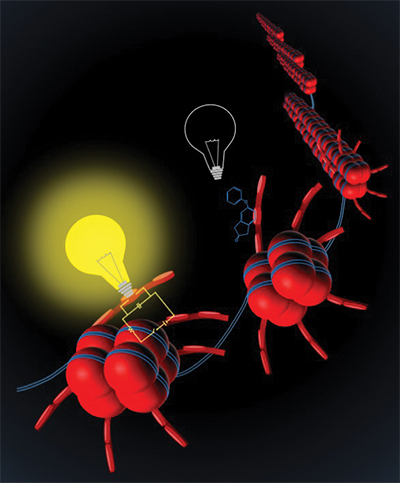JBC: In reading histone modifications, an oncoprotein is modified in return
Turning genes on and off is an intricate process involving communication among many different types of proteins that interact with DNA. These communications can go awry, resulting in conditions such as cancer.
 The lightbulb symbolizes TRIM24, a “histone reader” protein, which binds chromatin. Chromatin association triggers signaling to TRIM24, marked or “illuminated” by a post-translational modification called SUMOylation.Courtesy of Srikanth Appikonda
The lightbulb symbolizes TRIM24, a “histone reader” protein, which binds chromatin. Chromatin association triggers signaling to TRIM24, marked or “illuminated” by a post-translational modification called SUMOylation.Courtesy of Srikanth Appikonda
Researchers at the University of Texas MD Anderson Cancer Center have uncovered an unusual form of crosstalk between proteins that affect gene expression, suggesting new ways of inhibiting metastasis in cancer. The findings were published in the Journal of Biological Chemistry.
Tripartite motif-containing 24, or TRIM24, is an oncoprotein, meaning it is found in higher abundance in many types of cancer cells than in healthy cells. Michelle Barton’s lab at MD Anderson studies this protein. Previous research has shown that TRIM24 is, among other things, an epigenetic reader. This means that it detects certain chemical modifications of histones — proteins around which DNA is coiled — and induces other proteins to change their behavior in response, resulting in a different pattern of genes being turned on than if the histone had not been modified.
In the new study, Srikanth Appikonda, a former postdoctoral fellow in Barton’s lab, found something unusual. Not only did TRIM24 “read” histone modifications, but the act of reading resulted in TRIM24 itself being modified with a small protein tag called a small ubiquitinlike modifier, or SUMO. In other words, reading the message of the histone made the reader carry its own chemical message.
“This is the first time that we know of that the (histone) itself is imposing a code on the modifiers or readers,” Barton said.
What does the addition of SUMO to TRIM24 accomplish? Appikonda, graduate student Kaushik Thakkar and the other team members performed experiments to see how the genes that TRIM24 turned on and off in cancer cells differed when TRIM24 didn’t have SUMO attached.
They found that the SUMO-modified TRIM24 seemed to be regulating genes involved in adhesion between cells. Cell adhesion determines whether cancer cells stay in one spot or can travel and metastasize through the body.
“That’s really where these cell-adhesion molecules are coming into play: metastasis and migration of cancer cells,” Barton said.
Multiple proteins are involved in adhesion, and TRIM24 turned some off and some on. Therefore, it’s not yet clear what net effect TRIM24 has on metastasis in cancer patients. But understanding that TRIM24 is involved in this process gives researchers a place to look to learn how to stop it.
In the meantime, the SUMO modification also can be used as a possible marker in studies of other types of potential new drugs. Cancer researchers often are interested in disrupting TRIM24’s interaction with histones in order to prevent aberrant gene expression. By tracking whether TRIM24 has SUMO attached, researchers can test whether a potential drug has blocked the interaction successfully.
“The exciting thing about learning more about modifications of TRIM24, such as SUMO, is to be able to develop antibodies or other means to detect its presence,” Barton said. “(This) may be a better predictor of cancers in early stages or could be linked to potential for metastasis.”
Enjoy reading ASBMB Today?
Become a member to receive the print edition four times a year and the digital edition monthly.
Learn moreGet the latest from ASBMB Today
Enter your email address, and we’ll send you a weekly email with recent articles, interviews and more.
Latest in Science
Science highlights or most popular articles

E-cigarettes drive irreversible lung damage via free radicals
E-cigarettes are often thought to be safer because they lack many of the carcinogens found in tobacco cigarettes. However, scientists recently found that exposure to e-cigarette vapor can cause severe, irreversible lung damage.

Using DNA barcodes to capture local biodiversity
Undergraduate at the University of California, Santa Barbara, leads citizen science initiative to engage the public in DNA barcoding to catalog local biodiversity, fostering community involvement in science.

Targeting Toxoplasma parasites and their protein accomplices
Researchers identify that a Toxoplasma gondii enzyme drives parasite's survival. Read more about this recent study from the Journal of Lipid Research.

Scavenger protein receptor aids the transport of lipoproteins
Scientists elucidated how two major splice variants of scavenger receptors affect cellular localization in endothelial cells. Read more about this recent study from the Journal of Lipid Research.

Fat cells are a culprit in osteoporosis
Scientists reveal that lipid transfer from bone marrow adipocytes to osteoblasts impairs bone formation by downregulating osteogenic proteins and inducing ferroptosis. Read more about this recent study from the Journal of Lipid Research.

Unraveling oncogenesis: What makes cancer tick?
Learn about the ASBMB 2025 symposium on oncogenic hubs: chromatin regulatory and transcriptional complexes in cancer.

.jpg?lang=en-US&width=300&height=300&ext=.jpg)